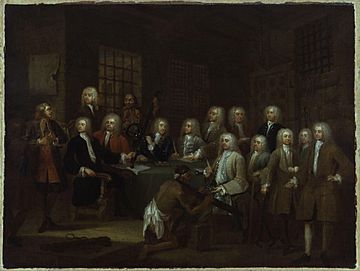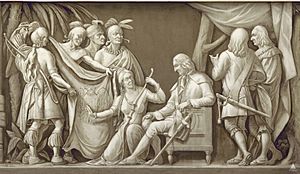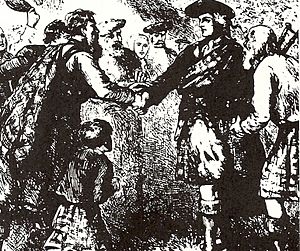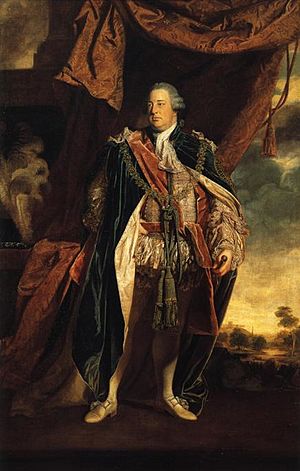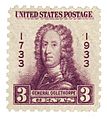James Oglethorpe facts for kids
Quick facts for kids
James Edward Oglethorpe
|
|
|---|---|
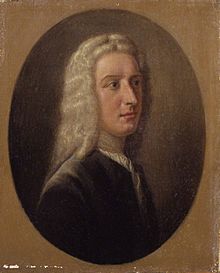 |
|
| Governor of Georgia | |
| In office 1732–1743 |
|
| Prime Minister | Sir Robert Walpole |
| Preceded by | Office created |
| Succeeded by | William Stephens |
| Member of Parliament for Haslemere |
|
| In office 1722–1754 |
|
| Preceded by | Nicholas Carew |
| Succeeded by | James More Molyneux |
| Personal details | |
| Born | 22 December 1696 Godalming, Surrey, England |
| Died | 30 June 1785 (aged 88) Cranham, Essex, England |
| Political party | Tory |
| Spouse | Elizabeth (née Wright) |
| Alma mater | Eton College, Corpus Christi College, Oxford, a military academy, Paris, France |
| Profession | Statesman, soldier, agriculturalist |
| Signature | |
James Edward Oglethorpe (born December 22, 1696 – died June 30, 1785) was a British soldier, a member of Parliament, and a kind-hearted person who helped others. He is famous for founding the colony of Georgia in what was then British America. As a social reformer, he wanted to help poor people in Britain start a new life in America. He especially focused on those stuck in debtors' prisons because they couldn't pay their debts.
Oglethorpe came from an important British family. He left college and the army in England to study at a military academy in France. He then fought in a war in Europe. In 1718, he returned to England and was elected to the House of Commons in 1722. He became well-known in 1729 when he led a committee that looked into the terrible conditions in British debtors' prisons.
After his report got a lot of attention, Oglethorpe and others suggested creating a new colony. This colony would be a safe zone between the rich Carolinas and Spanish Florida. In 1732, he received official permission to start the colony. Oglethorpe sailed to Georgia in November 1732.
He was a very important leader in Georgia's early days. He had a lot of power in both government and military matters. He also made a rule that banned slavery in the colony. During a war called the War of Jenkins' Ear, Oglethorpe led British troops in Georgia against Spanish forces from Florida. He tried to capture St. Augustine in 1740 but didn't succeed. However, he successfully defended Georgia from a Spanish attack in 1742.
Oglethorpe left Georgia after another failed attempt to invade St. Augustine and never returned. He later fought in a conflict in Britain in 1745. Even though he was cleared of any wrongdoing, he never led British troops again. He lost his seat in Parliament in 1754. Later, he secretly served in the Prussian Army during the Seven Years' War. In his older years, Oglethorpe was friends with famous writers like James Boswell and Samuel Johnson.
Contents
Early Life and Family History
James Oglethorpe's family was very old and important. They had supported King Charles I, who was not very popular. They faced difficulties when Oliver Cromwell was in power, but they became important again after the king returned in 1660.
James's father, Theophilus Oglethorpe, lived near the royal palace in London. He and his brothers were members of Parliament. Theophilus married Eleanor Wall, who worked for Queen Anne. They had ten children, and James Edward was their youngest son, born on December 22, 1696. Not much is known about his very early childhood. He was named after King James II, showing his family's loyalty to the royal family.
Early Military Adventures
When James was young, his father bought him a position as an ensign in the Queen's Foot Guards in 1707. This was a common way to start a military career back then. He went to Eton College and then Corpus Christi College, Oxford. In 1715, he left the army because his unit wasn't expected to see any fighting.
Oglethorpe then traveled to France, where his sisters lived. He went to a military school near Paris. The next year, he decided to join the Austro-Turkish War. He wanted to fight under a famous military leader named Prince Eugene of Savoy. Oglethorpe joined Prince Eugene's army in 1716. He was present at the Battle of Petrovaradin and served during the Siege of Timisoara.
He saw more action at the Siege of Belgrade in 1717. After his commander died in battle, Oglethorpe took over some duties. He was even offered a higher rank in the army, but he didn't accept it. He returned to England in 1718. Even though he hoped to join the British Army, he was not given a position.
Serving in Parliament
When James Oglethorpe was 26, he inherited his family's estate in Godalming, Surrey. In 1722, he was elected to the House of Commons as a Tory representative for Haslemere.
Early in his time in Parliament, Oglethorpe was involved in a serious incident where a man died. He spent five months in prison but was later cleared of any wrongdoing with the help of a powerful friend. He took his seat in the House of Commons in October 1722.
Some people thought Oglethorpe wasn't very active in Parliament at first. However, others said he was a good speaker who truly cared about the people he represented. He worked on many different committees. In 1723, he spoke out against banishing a bishop who was accused of supporting a rival to the king.
In 1728, Oglethorpe wrote a pamphlet about the poor conditions for sailors in the Royal Navy. He wrote about unfair practices like press gangs, which forced men into the navy, and problems with pay. This pamphlet showed his growing interest in helping people and led to his future work as a reformer.
Investigating Prisons
In the late 1720s, Oglethorpe became very concerned about the conditions in debtors' prisons. This happened after his friend, Robert Castell, was sent to Fleet Prison and sadly died there. Oglethorpe asked Parliament to investigate the prison warden. He was chosen to lead this committee, called the Gaols Committee, in February 1729.
As the chairman, he visited debtors' prisons and wrote detailed reports for Parliament. These reports showed many problems, like prisons being too crowded and diseases spreading easily. The reports especially criticized Thomas Bambridge, the warden of Fleet Prison. Oglethorpe pushed for reforms and for those in charge to be punished.
Even though these reports got a lot of attention, not much real change happened. Many people, including famous writers, praised Oglethorpe and his committee. However, some members of Parliament tried to stop changes from happening. A bill Oglethorpe helped create to remove Bambridge from his job was passed, but other ideas to improve prisons were ignored. Oglethorpe felt that justice was not served when Bambridge and others were found not guilty of charges against them. He then ended the committee.
Other Parliamentary Work
Oglethorpe continued to be involved in other issues in Parliament. He spoke against a large grant of money to the royal family, calling it too much. He also believed Britain should be ready for war in Europe.
After he left for Georgia, Oglethorpe was less involved in Parliament. He lost much of his influence after Robert Walpole, a powerful prime minister, lost his power in 1742. Oglethorpe mostly worked against those in power after that.
Founding the Colony of Georgia
While working on the prison committee, Oglethorpe became good friends with John Perceval. After the committee, Oglethorpe thought about sending unemployed people from London to America. In 1730, he shared his plan to create a new American colony with Perceval. He imagined it as a place for "the unemployed and the unemployable" to start fresh.
He soon received money for the colony. Oglethorpe also met Thomas Bray, a kind reverend who helped people. Oglethorpe became a trustee of Bray's charity, the Bray Associates, which supported humanitarian work.
At first, there was no specific location for the colony. But on April 1, Oglethorpe decided it would be in America. It became clear that a colony south of the Savannah River would be a good idea. It could act as a "buffer" or protective zone between the rich Carolinas and Spanish Florida. Oglethorpe chose this region on June 26. People sent to the colony would be both soldiers and farmers, making it "South Carolina's first line of defence."
Oglethorpe led the effort to promote the new colony and wrote many of the materials to encourage people to join. These writings appeared in newspapers and magazines, asking for donations and people to move to the colony.
In June 1732, Oglethorpe, Perceval, and other important Britons formed a group called the Trustees for the Establishment of the Colony of Georgia in America. They asked for and received a royal charter to create the colony of Georgia. This charter allowed them to settle the land between the Savannah River and the Altamaha River.
The next month, they chose the first group of people to send to the colony. Oglethorpe's mother had just died, and he decided to join the group and travel to Georgia himself. He was officially put in charge of telling people about the Georgia colony on August 3.
That summer, Oglethorpe helped a man named Ayuba Suleiman Diallo, an enslaved merchant, gain his freedom. Oglethorpe had been involved with a company that traded slaves, but after this experience, he sold his shares and resigned before leaving for Georgia. Oglethorpe sailed from England with 114 other people on the ship Anne in November 1732.
Life in Georgia
The ship Anne arrived in Charleston, South Carolina, in January 1733. When they reached Georgia on February 1, 1733, Oglethorpe chose a settlement spot far from the Spanish. Spain did not like their presence in the area, so Oglethorpe worked hard to have good relationships with the Native American tribes living there.
From 1732 to 1738, Oglethorpe was the unofficial leader of Georgia. He controlled both the military and the government. He was the most important trustee and the only one who actually lived in the colony. He also helped map out the colony.
Oglethorpe founded the Solomon's Masonic Lodge in 1734, which is still active today.
Early Leadership
Oglethorpe and the trustees created a detailed plan for settling Georgia, known as the Oglethorpe Plan. This plan aimed for "agrarian equality," meaning everyone would have a fair chance at farming. It was designed to support family farms and prevent big cities from growing too fast. Land ownership was limited to 50 acres. This included a town lot, a garden plot, and a 45-acre farm. People who could support themselves could get larger grants, but these were tied to how many workers they supported. Workers would get their own land after their service. No one could buy or inherit extra land.
Even though he arrived with limited official power, Oglethorpe quickly became the main authority in Georgia. He was "everything to everyone." He talked with the Yamacraw Indians, becoming the colony's ambassador to native tribes. He commanded the local army, managed the building of Savannah, and generally oversaw the colony. In early 1733, all important matters were brought to Oglethorpe first. He lived in a tent separate from the other colonists, and some called him "father."
Oglethorpe was known for dealing fairly with Native Americans. He negotiated with Tomochichi, the chief of the Yamacraw tribe, for the land to build Savannah. Tomochichi became Oglethorpe's strongest friend in the New World.
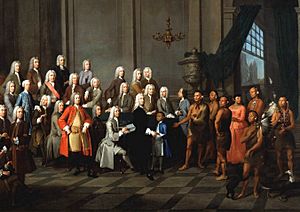
In 1734, Oglethorpe traveled to England with a group of Creek Indians, including Tomochichi. The Georgia trustees had invited Tomochichi to be there when Oglethorpe's treaty with the Yamacraw was formally approved. The group met King George II and his family. Oglethorpe was praised in London, though some worried about his plans to expand the colony, fearing it would upset the Spanish.
When Oglethorpe returned to England in 1734, he left a power gap in Georgia. There were disagreements between the civil and military leaders. This helped him decide to return. In December 1735, he sailed back to Georgia with 257 more immigrants, arriving in February 1736.
For the next nine months, Oglethorpe mostly stayed at Frederica. This was a town he designed to protect against Spanish attacks. He trained soldiers and oversaw the building of a fort. He also held a meeting with Native American tribes in 1736. Oglethorpe left the colony again in November to ask for a military regiment. He believed Georgia worked best when he was in charge.
The War of Jenkins' Ear
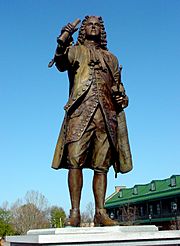
Oglethorpe believed that conflict with Spain was unavoidable because Georgia was meant to be a "buffer" colony. In 1737, he asked Parliament for money to build up Georgia's defenses. He was made General of the Forces of South Carolina and Georgia. He was also promoted to colonel in 1737. A Spanish invasion of Georgia was planned in March 1738 but was canceled.
Oglethorpe began preparing for war as early as 1738. He raised more troops and bought boats because the Royal Navy wouldn't send ships. He spent all his own money, over £100,000, on Georgia's defenses. He also worked to get the support of Native American tribes.
The War of Jenkins' Ear officially began in 1739. After receiving a letter from King George II, Oglethorpe encouraged the Creek Indians to attack Spanish Florida. In December, he led 200 men on a raid into Florida. They captured Fort Picolata and Fort San Francisco de Pupo, burning one and claiming the other for Georgia.
South Carolina was slow to provide help, so Oglethorpe went to Charleston to ask for more men and supplies. They agreed to send some soldiers and provisions. Oglethorpe attacked Fort St. Diego and captured it in May. He also received help from some Native American allies.
Oglethorpe faced challenges, like not having enough equipment or skilled engineers to attack a city. The Royal Navy's blockade of St. Augustine was not very effective. In June, Spanish ships managed to get through the blockade and reinforce the city. The navy planned to leave in July due to hurricane season. Oglethorpe was forced to give up the siege of St. Augustine.
Spain launched a counter-invasion of Georgia in 1742. Oglethorpe led his forces to a decisive victory at the Battle of Bloody Marsh. In February 1742, he was promoted to brigadier general. He led another unsuccessful attack on St. Augustine in 1743. That year, William Stephens was named the president of Georgia. This happened because the trustees were frustrated with Oglethorpe's lack of cooperation. Oglethorpe still controlled Frederica, but Stephens managed Savannah.
Historians believe Oglethorpe's military contributions were very important. While some blamed him for the failure at St. Augustine, many agree he made mistakes but was not the main reason for the defeat. The war ended in November 1748. By 1749, the trustees had lost interest in Georgia, and they gave up its charter three years later.
Banning Slavery
In what was called the Georgia Experiment, Georgia initially banned black slavery in the colony. Oglethorpe was against slavery for several reasons. He felt it would make Georgia less effective as a protective buffer, as enslaved people might work with the Spanish to gain freedom. Also, Georgia was not meant to have a huge economy like the Carolinas, so it didn't need slaves. The colony's economy was planned to be based on silk and wine, which didn't require large-scale slavery. He also believed slavery would harm the "manners and morality" of Georgia's white settlers. Because of Oglethorpe and other trustees, the House of Commons officially banned slavery in Georgia in 1735.
Many people criticized Oglethorpe for supporting the ban in the late 1730s. After he returned to England, the trustees asked for the ban to be lifted in 1750. Some have suggested that Oglethorpe owned slaves on his land in South Carolina while slavery was banned in Georgia. However, there is no clear proof of this, and it seems unlikely.
Return to England
Oglethorpe returned to England in September 1743, after the last attack on St. Augustine failed. He remained somewhat involved in Georgia's affairs but never went back to the colony. He was later investigated for misusing funds but was found not guilty.
Oglethorpe married Elizabeth Wright in September 1744.
He fought in the British Army during the Jacobite rising of 1745. As a major-general, he led troops against Scottish invaders. He was blamed for a British defeat at the Clifton Moor Skirmish because he allowed the Scots to escape. He was accused of disobeying orders and possibly supporting the Scottish rebels. Oglethorpe faced a military trial but was found innocent in 1746. He was promoted to lieutenant general in 1747. However, the Duke of Cumberland, who was in command at Clifton Moor, prevented Oglethorpe from holding military command again.
Oglethorpe then worked on various reform efforts but had little success. He lost his seat in Parliament in 1754. His loss might have been because he moved to Essex and supported a law that helped Jewish people become citizens. Some believe the election was unfair.
Later Life and Passing
Not much is known about Oglethorpe's life after he retired from Parliament. He became friends with many famous writers in London, including Samuel Johnson and James Boswell. Oglethorpe and Boswell became especially close. Boswell and Johnson even offered to write a book about Oglethorpe's life, but it was never published.
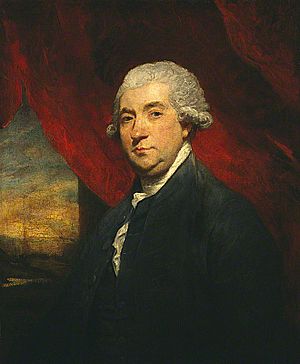
From 1755 to 1761, Oglethorpe was out of England. These are called his "missing years" because little is known about what he did. He asked King George III to restart his Georgia regiment but was unsuccessful. He then traveled to Rotterdam and asked his friend, James Francis Edward Keith, for a position in the Prussian military. It is believed Oglethorpe used a fake name and joined the Prussian army in 1756. He likely fought with Keith and Frederick the Great during the Seven Years' War. He was wounded in a battle in 1758. Keith reportedly died in Oglethorpe's arms during the Battle of Hochkirch. Oglethorpe left the army in 1759 and returned to England by 1761.
In 1768, Oglethorpe secretly published essays supporting Corsican independence. He strongly argued for their freedom, along with his friend Boswell.
As colonists in America became more vocal about their problems with Britain, Oglethorpe privately agreed with them. From 1777 to 1778, Oglethorpe and Granville Sharp tried to convince British leaders to end the war and give the colonists full rights as Englishmen. There was a rumor that Oglethorpe was offered command of the British Army in the American Revolutionary War, but historians have found no evidence of this. In June 1785, Oglethorpe met John Adams, who would become the second U.S. President, twice in London.
James Oglethorpe died on July 1, 1785, at his estate in Cranham, Essex, east of London. He was 88 years old. The cause of his death is unknown, but it might have been a disease like the flu that turned into pneumonia.
Legacy and Memorials
Many places are named after James Oglethorpe. In Atlanta, Oglethorpe University and Oglethorpe Park honor him. In the state of Georgia, Oglethorpe County and the town of Oglethorpe bear his name. The James Oglethorpe Primary School in Cranham, England, is also named after him.
In 1986, the cadets at the University of North Georgia adopted the name "Boar's Head Brigade." The boar's head was part of James Oglethorpe's family crest. It symbolizes a fighting spirit and hospitality, which are important parts of Georgia's history and the spirit of the cadets.
All Saints' Church in Cranham, where Oglethorpe was buried, was rebuilt around 1871. His marble memorial is still on the south wall of the church. In the 1930s, the president of Oglethorpe University tried to move Oglethorpe's remains to a special shrine at the university in Atlanta, but permission was not granted.
The James Oglethorpe Monument in Chippewa Square, Savannah, Georgia, was unveiled in 1910. The statue shows Oglethorpe facing south, towards where Spanish Florida once was, with his sword drawn. Another square in Savannah, Oglethorpe Square, is also named for him.
The city of Fort Oglethorpe in Catoosa and Walker County, Georgia, is named after him.
Anniversaries celebrating Oglethorpe have led to donations, like the altar rail at All Saints' Church, given by a charity in Georgia. In 1996, Georgia Governor Zell Miller attended celebrations for Oglethorpe's 300th birthday in Godalming and at Corpus Christi College, Oxford.
Corpus Christi College has two portraits of Oglethorpe: a drawing of him as an old man and an oil painting.
Images for kids
See also
 In Spanish: James Edward Oglethorpe para niños
In Spanish: James Edward Oglethorpe para niños


